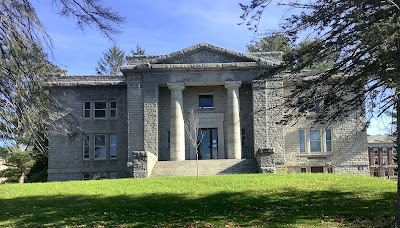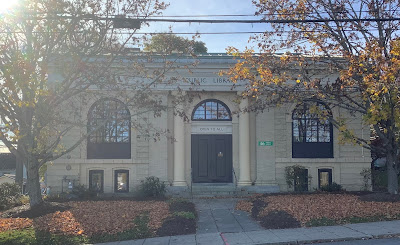When I reached Bangor and the more populous southern third of the state the Carnegies started coming fast and furious, two the first day and four the next. The first came on the campus of the University of Maine in Orono, eight miles north of Bangor. The sprawling campus of 11,500 students resides on an island formed by the Stillwater and Penobscot rivers. It was largely populated with red-brick buildings. The monumental Carnegie was the lone exception constructed of grey stone accentuated by two monolithic columns. It stood alone on a slight rise in the center of a large quad as if it were a place of worship. It ended its days as a library in 1947 and has been renamed Carnegie Hall, serving as home to the Virtual Environment and Multimodal Interaction Laboratory (VEMI).
Just five miles to the north in a town bearing the name Old Town was a public library funded by Carnegie. It was a monument of a building too, though of a more modest scale. The entry stated “Open to All,” but one had to enter around back through a large addition beside a sizable parking lot. The ride from Orono and onward took me past several ice rinks. With skating a popular pastime the university is a hockey powerhouse having won the national championship twice.
I would have had a third Carnegie for the day in Pittsfield, forty-five miles southwest, but the imminence of rain forced me into a motel eight miles before I reached it.
I could have pushed on, as Pittsfield had lodging as well, but it was a higher-priced inn. I was happy to opt for a typical small-town motel emblematic of Americana rather than something more opulent. It didn’t offer breakfast, but had a couple of bowls of leftover Halloween candy that I took full advantage of.
The next morning when I reached the exemplary domed Pittsfield Carnegie at eight a.m., two hours before it would open, I was somewhat regretting I hadn’t pushed on the afternoon before and paid the premium of staying at the inn so I could have had the pleasure of standing under the dome of the Carnegie and marveling at it’s interior as well as exterior. As the Carnegie in Old Town, it had a large, unobtrusive addition.
It had been one stunning Carnegie after another and the next kept the string going. It was almost too much for one day. It is the first building one encounters on the campus of Good Will-Hinckley, a charitable organization founded in 1889 by George Hinckley dedicated to educating youth and changing lives as a boarding and day school. The library now provides space for offices and classrooms. When I rolled up on my bike an administrator entering the building regarded me with suspicion and asked what I wanted.
It was twelve miles south on a hilly, trafficless road to the next Carnegie in the small town of Oakland. It was on a more modest scale than the previous four, but continued the neo-classic style with a pair of columns. It had an addition behind it. I was happy when a woman parked her car on the street in front of the library rather than going into the parking lot behind and walked right in, as I feared it would be another expanded Carnegie requiring entry on the side or in the back. Just inside the door a plaque gave credit to Carnegie and a woman who provided the land for the library.
Just five miles away over a long climb and under Interstate 95 I had my fourth Carnegie for the day in the large city of Waterville. Rather than columns it had a tower. Including the lower level, it had four floors, double even the larger Carnegies. The fourth floor had two reading rooms. The floor below had a fireplace accompanied by the portrait of Carnegie with an open book on his lap. An addition to the side and the back were so seamless it was hard to tell they weren’t part of the original building.
Of the twelve remaining Carnegies on my sweep of New England only three will require a jaunt of more than twenty-five miles. One however is out on an island that will take an hour and fifteen minutes to reach by ferry. I’m already looking forward to that usual jolt of pleasure upon my first glimpse of it, knowing that the anticipation will be building while at sea.
I have my route plotted all the way to Schenectady, where four final Carnegies in the vicinity await me. I’m somewhat regretting I won’t be catching the train home in Rochester, as I just learned from Diane Jenks on her latest edition of The Outspoken Cyclist Podcast that Rochester is the home of the women-specific Terry bicycle company. If I’d known before I set out on these travels, it would have been my first destination when I got off the train.
It was founded in 1985 by Georgena Terry, who traced her career in her wide-ranging conversation with her long-time friend Jenks on the podcast. She’d been a mechanical engineering student at Carnegie-Mellon in Pittsburgh. When she graduated and began work in Rochester with Xerox, she began making bicycle frames for friends with geometries better suited for women. Within a couple of years her business grew from a handful of frames to hundreds. Before long she she expanded her business to other woman-specific cycling gear, including saddles, pioneering the middle cut-away.
The podcast was a most informative and entertaining conversation between two feisty, outspoken women who have been in the bike business for decades. Terry is ever mindful of the female perspective. Her website states: “I hope I’m part of a movement that encourages women to think for themselves. To be stubborn. To break the rules. And not be afraid to be a pain in the butt sometimes.”
On the podcast she pointed out several differences between men and women. She says she’s never had a woman request a carbon-fiber frame, saying that men always want the latest technology, while women are content with what has worked in the past. She said many of her clients are women who tell her they always wanted a Terry bike having heard about them years before. Jenks chimed in that women remember things, while men don’t. Georgena added, “And men don’t always listen.” It was almost as if they’d both just seen “Barbie” and couldn’t resist lampooning the patriarchy.








No comments:
Post a Comment